Disclaimer: This page may contains affiliate links from amazon and other sites.
“Ornamental Fish” is a nickname for Koi. They are one of the top and most popular pet fish around the world. Koi can be used for both decoration and commercial purposes. Depending on various things like – genetics, environment, nutrition, age, etc., a Koi can grow from 12 inches to 36 inches long and weighs from 12 to 30 pounds.
As I’m engaged with the fish industry for quite a while now (08 years or more to be exact), a general query of every Koi owner has (whether it’s in an aquarium or pond) –
How Fast Do Koi Fish Grow, or How Fast Do Koi Grow?
- In general, a koi is about to grow 0.71 mm per day or about 2.13 cm every month for the first 06 months of its life (5.1 Inches at the end).
- And 0.58 mm per day or 1.74 cm per month for the next six months of the first year.
- By the age of one, your Koi should be around 9.2 inches long and approximately 8 ounces of weight.
- In the second year, per day growth rate should be around 0.54 mm
- At end of the age of two, it will be around 15.6 inches long and 37 ounces of weight.
- Gradually the Koi fish growth rate will decrease as time passes.
- Needless to say, there are factors like- Koi fish genetics/breed, environment, age, and nutrition that will play a big role in how fast do your koi fish will grow.
(We provided more details below about the koi fish growth in this content, so keep on)
So, today we will discuss in detail – how fast will Koi grow, or how fast your Koi fry grow? The lifespan of a koi. What makes koi fish grow faster? What’s affecting your koi growth? And more related to these questions about your Koi.
Koi Fish
Koi fish are part of the common carp family lineage; they are known as colorful and decorative carp. Early 19th century, when the modern Japanese Koi were caught, bred, and kept by the farmers. Though, carp domestication can be traced back to the 4th century in China.
There’re now dozens of varieties and colored Koi available around the world.
How big do Koi get?
As we mentioned earlier, it depends on different variables. A piece of common knowledge about koi growth is-
- Usual domestic Koi can get from 12 to 15 inches.
- Japanese Koi can grow up to 26 inches.
- And the Jumbo-sized Koi can grow up to 36 inches long.
So, Koi fish can be up to 100 cm, which is around 3.5 feet long.
How long does it take for a koi fish to grow to Full Size?
7 years, on average, Koi reach their full potential.
80 out of 100 people agree 10th year is their maturity age. After that, changes are hardly noticeable.
But a Koi fish can grow up to 13 years or more.
Koi Food: What kind of food do Koi eat?
Koi have a vast range of food habits. They are omnivorous, starting from small bugs, plants, algae, insects, and almost everything found at the depths of the water to fish food from the store.
An article regarding the Koi fish diet and feeding guidelines, if you’re interested.
Even Koi can have people’s food like- shrimp, lettuce, peas, rice, cereal, and many more.
Reproduction and Development of A Koi: how often do Koi fish lay eggs?
Twice in a year, that’s the Koi’s Spawn rate. First, spawning is more productive than the second one. The breeding season is in the spring.
At what age do Koi Breed?
3-6 years is the peak mating time for Koi (males are 3-5, and females are 4-6 years). Though, Koi can produce baby koi up to 15 years of age.
They attach their eggs to the submerged water plants or other objects.
The lifespan of Koi:
The average lifespan of a Koi is – 25-40 years.
Proper care and the environment will increase the lifespan of a koi substantially.
The oldest Koi was recorded, named Hanako, in Japan. It lived 226 years before dying in the year 1977.
Max Tribulation, Marine biologist
“They usually don’t get more than 15 inches, but the largest types can be around 36 inches. They normally live for about 30 years, but it’s not unusual for them to reach 100 if well cared for. The oldest Koi was 226 when it died in the 1970s. It can take more than 10 years to get to full size.
Basically, if you raise them the cheap American way, in a backyard pond, or a mini pool at a Chinese restaurant, you can expect to keep them for about 30 years and get foot-long fish. If you take the time and money to care for them, you can expect them to outlive you and be large enough to feed a family of 6.”
How Fast do Koi Grow? Or, How Fast do Koi Fish Grow?
The growth of a Koi depend on several aspects other than breed or genetics. Water quality, size of the pond or container, pond depth, nutrition or food, water temperature, age, and the Koi population in a pond all have a significant role in the growth rate of a Koi Fish.
On average, a Koi should be around 12 to 36 inches long at the age of 10. Most Koi will stop growing after that. Some still may grow in health and length, but you wouldn’t notice much difference.
Here’s a Koi Growth Chart or table for you to complete an understanding of how fast do koi fish grow? (expected growth)
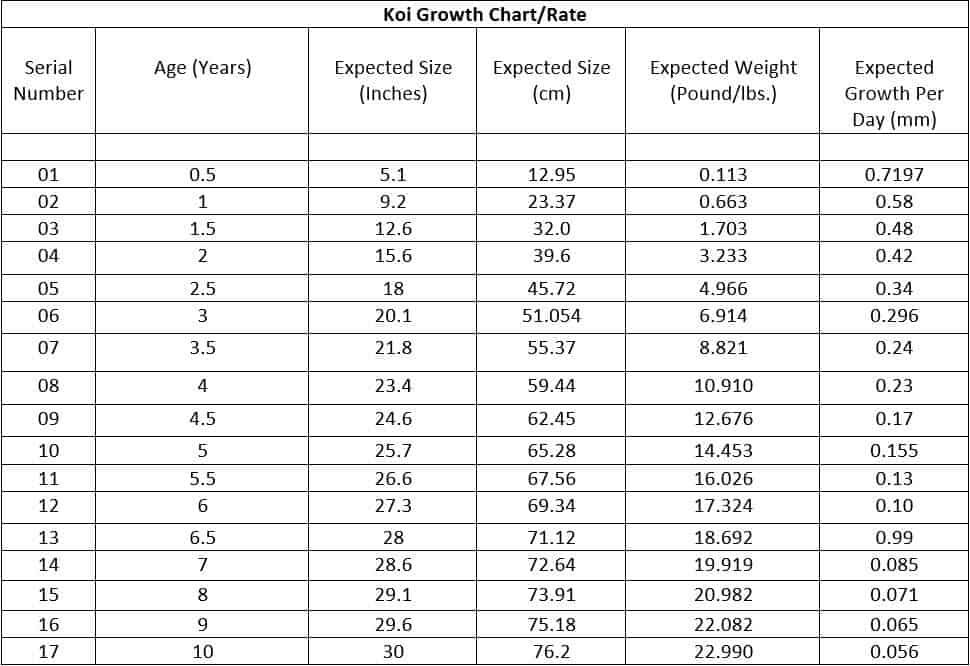
In this table: the 1st column is just a serial number (since we have divided the first seven years into fourteen periods), not significant.
2nd column shows the age of Koi fish over ten years.
3rd column is expected koi size in inches, and the 4th one is in centimeters.
The last column shows the per-day growth rate of a Koi over 10 years.
For your better understanding, we have run through these data in Excel and prepared charts for these values and information. Let’s look at them:
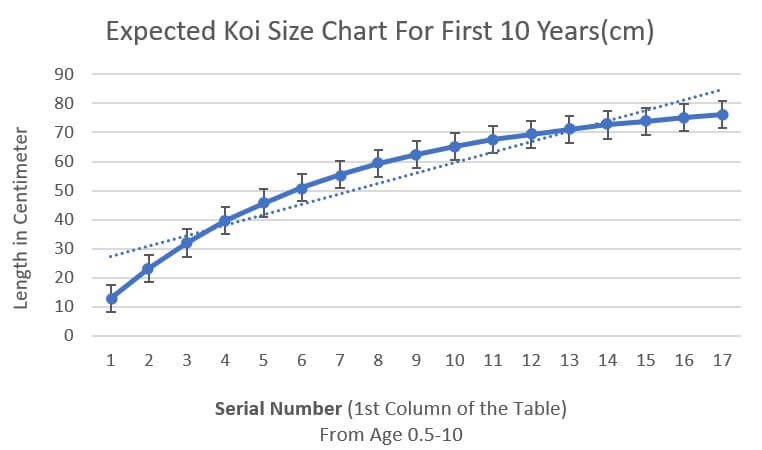
This one shows the probable growth of a Koi over 10 years. You can see in the chart that from 1.5 years to 5.5 years, where the size is 70 centimeters, the growth rate is higher than the standard trend line (middle unclear dot line).
Koi fish grow faster at an early age. Later on, growth becomes slower. Gradually it decreases until Koi reaches maturity.
By the age of 10, Koi should be around 75-80 centimeters.

This one is a Koi weight growth chart for over ten years. Just like their length, their weight gaining rate rises after early time. For 1.5 years, their weight gain increases significantly.
After reaching 5.5 years, gaining new ounces slows down a bit. And subsequently, the rate decreases over time.
Here you can see, that Koi fish become around 23 pounds at the end of the 10th year.

This chart shows a clear view of “How Fast Do Koi Grow” and how a Koi continues the grow in length overtime every day for the first ten years.
In the first six months, Koi grow around 0.72 mm per day and 0.58 mm for the rest of the first year. Over time, the per-day growth rate decreases.
At the end of the 10th year, growth becomes only 0.056 mm per day.
Why do we show a 10-year chart?
The majority agrees that the tenth is the final year of maturity of a koi. That’s why we put the charts of 10-year in size and weight growth.
As we already mentioned above, Koi have around 40 years of lifespan. So, what will happen then?
If your Koi can live as much as 40 years or more, the growth will be stunned after the 10th year?
No, that’s not likely to happen. The growth will continue mostly in weight. An increase in length won’t be that noticeable.
Then, what could be your Koi’s possible weight and size?
To answer this question, we researched the available data in our hands and run through some probable statistics analyses in excel.
After working for a long time with the available values and checking on the Koi fish history, we were successful in coming up with a probable weight and size of a Koi, if it can survive as much as 50 years.
That’s right!
You will have a good idea of how much can a Koi get if it can live that long.
Oldest Koi was recorded in Japan, Hanako named, in the 19070s. Hanako lived about 226 years and died in 1977.
The biggest Koi was recorded in 2007 in England, Big Girl named. She was 4 feet (1.2 meters) long and weighed over 90 pounds.
That’s crazy!
We didn’t take those extreme cases into our study. All the values here are the average data we had available in our hands during this work.
Now, let’s check our study results on 50-year Koi:
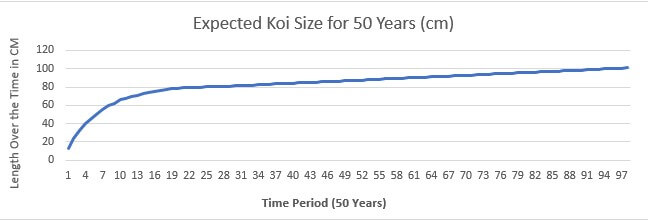
Look at that! 100 centimeters!
This is insane. If a Koi can live about 50 years, the average length can reach around 100 centimeters. Again, this statistic is based on probability theory.
Proper care and environment for a Koi can easily lead to living this much longer.
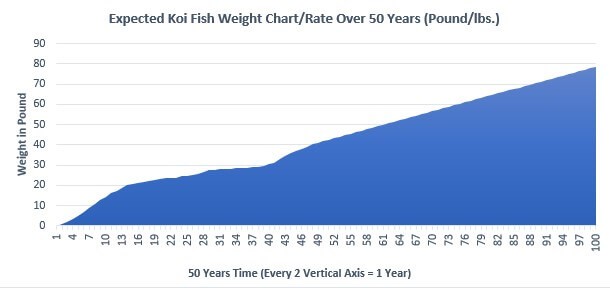
Another crazy number is here too, around 80 pounds (78.61 is the exact value). Your Koi can reach around eighty pounds in weight if it can live for around 50 years or more.
After receiving these two results, I was like- Wow, Really!!
Breaks on the graphs are part of the correction for standard errors and possible uncertainties. So, don’t get confused, what happened there!
So, the basics are good care of Koi, and related factors can fuel tremendous growth in a Koi (can cross our probable estimation given here), without good care of all the things, your Koi may not grow near as much as our estimation.
Koi not Growing: 12 Factors affecting Koi Growth
There’re several factors that influence Koi’s growth. People wonder, why are my Koi fish not growing? But you see people showing big Koi online. What’s the problem with yours then?
Let’s check these factors, which can play a significant role in Koi growth:
01. Koi DNA/Genetics/Breed:
Even though you’re providing everything in your arsenal to your Koi, they may not grow as much as you expect. Why do you ask?
Because of the genetics, DNAs, or breed of a Koi may be from smaller Koi carp lineage.
Just like we humans are, some people are short, tall, white, black, Asian, and many different types. So, why do we differ from each other, that’s the reason for our DNA and genetics. We are a product of our mom and dad. Therefore, their genetic combinations make us like we are now.
Jumbo Koi is the largest Koi breed in the market. They can reach about 36 inches in length.
So, if your Koi is from a small genetics’ lineage, it wouldn’t grow as much as other bigger genetics Koi.
02. Space For A Koi
The growth of a Koi highly depends on the available space it has. On average, 90% of Koi don’t grow at their full potential because of overcrowding place.
Koi fish need space to grow. Where you should keep 15 Koi, you may be keeping 30 Koi in that place. It causes space constraints. This may be a reason for the stunted growth of your Koi.
Koi Pond Size Per Fish:
You can keep a koi pet fish with 10 gallons of water and one inch of space.
For mid-level outcomes, you can put every fish with 50-100 gallons of water.
For the best, you keep 1000 gallons for every fish. Growth will be notable and amazing in this condition.
How many gallons of water per Koi fish/GPK (gallons per Koi)?
We recommend the following GPK rates based on their size:
For Smaller Koi (2″ – 8″) = 100 – 150 gallons
Medium Koi (8″ – 14″) = 250 – 300 gallons
Large Koi (14″ – 24″) = 400 – 500 gallons
For Jumbo Koi (24″ – 36″): 750 – 900 gallons
03. Food/Nutrition
This is one of the best Koi food on the market. Click this link or image for visiting the shop.
The Koi Clay or Pond Clay also can have a good effect on your Koi’s growth.
In the wild, a Koi can access lots of different types of food access; which aren’t available in their captivity.
Don’t know what are the right foods for your Koi! Read this- What do koi fish eat
How many times a day should I feed my Koi?
Experts suggest 3% food of a Koi weight every day and give them in five meals.
Koi can eat many human foods too, like- lettuce, orange, cabbage, sweet peas, cheerios, shrimp, and more. other than those, Koi will help you by eating the Algae too. Though, they aren’t the most popular algae eaters.
Here’s a Study on the Comparison of food selection and growth performance of koi carp.
Can Koi be overfed?
Yeah, Koi can be overfed. Overfeeding isn’t good for fish. It may cause sickness. So, provide the right amount according to your fish’s age and breed.
However, dying from overfeeding isn’t a normal case.
A study on using various rations or food on juvenile common carp.
04. Water Quality and Water Temperature
You should check your water quality and temperature twice a week.
Water quality check includes-
Total Hardness GH check of the water: It measures the amount of lime dissolved in water. Hardness less than 100 ppm (mg/l) is soft water.
Carbonate Hardness KH: It measures the water hardness caused by the carbonate and bicarbonate presence in the water.
To test your pond or aquarium water, you can use this product-
What is the best water hardness level for Koi?
- 0-17.1 mg/l is counted as soft
- 0-60 mg/l (milligrams per liter) is slightly hard
- 61-120 mg/l as moderate
- 121-180 mg/l is hard
- And more than 180 mg/l is very hard.
Acidity pH value Check. This measures the acidity levels in the water, which is the pH value.
What is the best pH value for Koi?
pH value ranges from 0 to 14. Here, 0 is the most acidic, and 14 is the most basic.
pH value of 7.0 is the best and neutral value.
Water temperature: Koi can handle from 35 up to 85 F. Koi is a cold-water fish but grow better at water temperature. Their metabolism reacts to the water temperature.
What is the best water temperature for Koi Fish?
The best water temperature for Koi fish ranges from 60 to 75 F.
Temperature 17/18 degrees is for skin quality, 22 degrees goes for body development, 24 or higher is work on length or growth of Koi, long high temperature can cause Koi to lose its color.
Here’s a research paper on rations and temperatures’ effect on juvenile common carp:
A research on water temperature for koi fish
05. Water Change (Oxygen) for Koi Fish
Water in your pond or aquarium may have less oxygen than the Koi require. Changing water will increase the oxygen level in the water.
How often should I do water changes in my aquarium/pond?
Change at least 10% of the water every week. If every week is not possible, then change around 25% of the water every 2-4 weeks.
And, two times, the total water should change in a year.
Using a pump or other aeration device in water change will increase the oxygen level in the water.
Here’s a study on the Effect of water exchange on water quality and the production of ornamental carp.
06. Gender
As you may never care about your Koi fish’s gender, you will be surprised to know that; female Koi tend to be bigger than male Koi.
So, next time you go to buy new Koi fry, ask for female ones.
07. Water Flow
Having flow in the Koi pond or aquarium is important as it helps them like doing work out.
Increase the water flow during their active time. It will help them grow better in the long term.
08. Stress
Hanako, the oldest Koi carp, has recorded in 1977 in Japan. Hanako was doing fine on its own. But later, they brought it to the museum for display, it couldn’t handle the stress and died at 226 years old.
What causes stress to a Koi?
Attack of parasites, other, aggressive fish in the tank or pond, predator’s appearance continuously, poor water quality, competition for food, and high temperature in summer all can cause high stress on a fish. So, try to keep these under control in a moderate form.
09. Depth
Too shallow water hinders Koi’s growth. Koi tend to go deeper into the pond as it sunrises, and they are prone to get burned in the sunlight.
So, keeping enough depth is good for Koi fish growth.
Here’s a study on Observations on aquarium depth preference of koi carp.
Minimum Depth for Koi Pond:
The minimum depth can be from 60 cm (2 feet) to four feet or more. According to the number of fish and size, the depth should be increased.
10. Clay supplement
As you use tap water in your pond or aquarium, this water doesn’t have many natural minerals in it. Therefore, your Koi doesn’t have an advantage compared to mud pond koi. Mud pond koi tend to be larger and healthy.
if you’re looking for a clay supplement for your pond and fish, check this product–
Using clay supplements in your tank can increase the growth potential of your Koi fish.
Here’s the study of A comparison of growth, survival rate, and a number of marketable koi carp produced under different management.
11. Age
You saw our Koi growth table and charts. You should notice that the growth rate increase and decrease at different age of a Koi.
The growth rate increases in the early five years; later, the growth rate starts to fall down as time passes.
So, age has a significant role in your Koi growth.
12. Enough Rest:
During winter, don’t push Koi for regular feeding, exercise, and other activities, like temperature improvement for growth.
Let them rest through this time, and improve their color and skin development.
So, Now –
How big do Koi get?
Domestic Koi are a smaller breed, and they can grow around 12 to 15 inches in length.
Japanese Koi are medium breeds, and they can grow around 22 to 26 inches long.
The largest breed, Jumbo Koi, can grow up to 36 inches.
If your Koi doesn’t become like this, then check these 12 factors above. These factors may be affecting your Koi growth from reaching their full potential
How to grow Koi fast/ What makes Koi fish grow fast?
Another common query of every Koi owner: How can I make my Koi grow faster?
13-step guidelines to grow your Koi Faster than others:
- Choose a larger breed for the starter
- Choose the Female ones
- Give them proper meals with an appropriate amount of proteins, carbohydrates, and fats.
- Don’t overcrowd your pond or tank
- Maintain water quality and temperature
- Take good care in winter
- Make your pond deeper
- Keep them stress-free or control stress
- Increase the water flow
- Change the water more frequently
- Feed them at least 5 times a day
- Having enough natural food in the pond
- Use clay supplement to improve your water quality
Frequently Asked Question (F.A.Q)
How fast do koi fry grow?
- In general, a koi fry is about to grow 0.71 mm per day or about 2.13 cm every month for the first 06 months of its life (5.1 Inches at the end).
- And 0.58 mm per day or 1.74 cm per month for the next six months of the first year.
- By the age of one, your Koi should be around 9.2 inches long and approximately 8 ounces of weight.
- In the second year, per day growth rate should be around 0.54 mm
- At end of the age of two, it will be around 15.6 inches long and 37 ounces of weight.
Do Koi grow faster than Goldfish?
Koi grow faster than Goldfish. Koi will be doubling easily, if not tripling in the fast year.
On the other hand, Goldfish may reach only a couple of inches in length and survive around ten years or more.
Do all koi fish grow big?
No, all Koi fish doesn’t grow big.
- Domestic Koi are a smaller breed; they can grow around 12 to 15 inches in length
- Japanese Koi are medium breeds, and they can grow around 22 to 26 inches long.
- The largest breed, Jumbo Koi, can grow up to 36 inches.
How long does it take for a koi fish to grow to full size?
It’s 3,5 or 7 years, depending on various breeds and situations. Growth rates aren’t the same for every breed.
Some breed takes 10 to 13 years to get matured.
Even after that, the growth may continue. But it won’t be too noticeable.
Winding Up
We hope we’ve covered all your queries of you as we promised in the intro of this article.
Now you know: how fast do Koi fish grow? That varies from year to year; the first six months are about 0.72 mm per day and 2.13 cm every month.
The latter of the fast year is a 0.58 mm per day growth rate.
We have provided Koi’s growth charts, Koi fish weight charts, and even probable 50 years statistics on your Koi.
But Koi growth isn’t an independent variable. It depends on 12 several other things to count on for reaching their full potential.
At last, we provide a short note on “how to grow koi fast?”.
We are always eager to know your opinion on our writing, what you liked, what you didn’t like, where we can improve more, and anything you have to say. So, leave a comment to let us know your opinion.
Well, here’s a question we like to hear from you: What are you feeding your Koi right now?

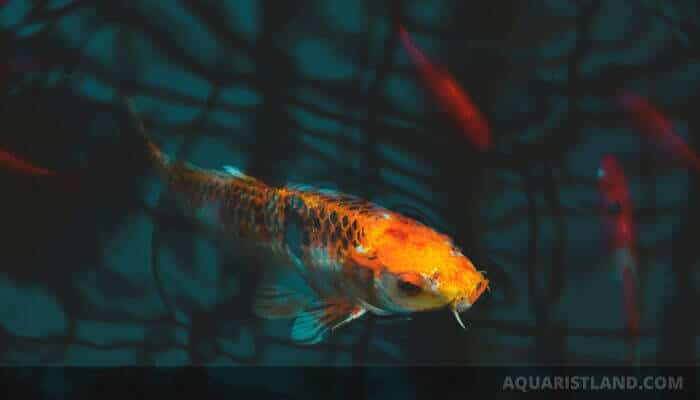



Thank you for education on KOI. I will now go back to the drawing board to convert my pool into a pond. As I now figured out that the current one will be an issue in the next year or two. Thank you.
Glad to hear that. And, you’re most welcome
on the Other hand, bad food can cause health deterioration and serious health issues in some cases. And Koi fish’s growth and development are highly dependent on their diet. A good diet can make them healthier and more.
Thanks for your valuable input.
Hey very nice website!! Guy .. Excellent ..
Wonderful .. I’ll bookmark your blog and take the feeds also
I’m glad to find a lot of helpful information here within the put up
thanks for sharing. . . . . .